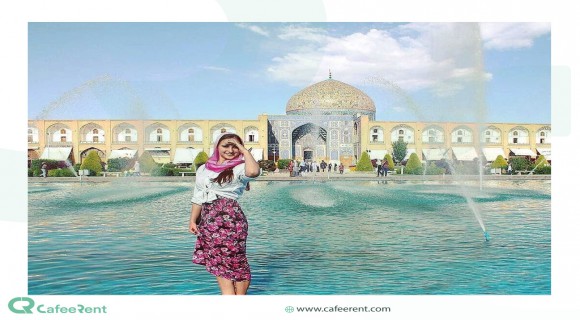Everything about Naqsh-e Jahan Square in Isfahan

Naqsh-e Jahan Square is a historical place that has been present in Isfahan since the Safavid era.
The square was built by the order of Shah Abbas I in 1598. It was designed by an architect named Mir-Ali Mokri (1513-1588).
The square was built to commemorate the victory of Shah Abbas' army over their enemies at the battle of Khaybar.
In addition to being a major religious and cultural center, Naqsh-e Jahan Square also played an important role in Isfahan's economic development. In this blog we are going to review this architectural masterpiece.
History of Naqsh-e-Jahan Square
Naqsh-e Jahan Square is a public square located in the city of Isfahan, Iran.
It is one of the largest squares in the world and has been a UNESCO World Heritage Site since 1979.
The square was commissioned by Shah Abbas I as part of his plan to make Isfahan the most beautiful city in the world.
And it became one of his most important projects in terms of architecture and art.
The square is named after the city of Isfahan, which was founded by Shah Abbas.
The square was built to commemorate the victory of Shah Abbas' army over their enemies at the battle of Khaybar.
The battle was a decisive victory for the Safavid army and marked an end to several centuries of jihad against them by Arab tribesmen.
It also brought Persia under Shah Abbas' rule and made it one of the most powerful states in medieval times with its control over Iraq, Syria, Lebanon and Palestine among other things (including Jerusalem).
During the time of Shah Suleiman and Shah Hussein, who were the last Safavid kings, this square lost its glory and its rivers and trees dried up.
Many parts of this square were destroyed during the Qajar period, and the change of the capital also caused more neglect to this square.
During the Pahlavi regime, Reza Shah started the reconstruction of this square and the buildings in it.
Spirit was breathed into this square again and economic prosperity returned to it.

The square covers an area of about 2 hectares (5 acres).
It was completed in 1602 and served as an important gathering place for religious ceremonies, political events, and trade fairs.
Numerous monuments surround this large space, including mosques and shrines to commemorate various events in history such as wars or weddings.
The square has been an important part of Iranian culture for centuries and continues to be a popular tourist destination today.
The monument is located in Isfahan and was designed by Mir-Ali Mokri, an Iranian architect who worked with Shah Abbas' son and successor, Sultan Husayn.
Naqsh-e Jahan means "The Maiden's Palace" or "The Palace of a Thousand Windows".
Mir-Ali Mokri did great job, who set out to create a cityscape that would reflect how "the world would look like when [he] had completed his work."
Mir-Ali Mokri is considered to be one of Iran's greatest architects because he created many beautiful buildings during his lifetime, including mosques, palaces and fortresses. He was born in 1513 and died in 1588.
Economic development by Naqsh-e Jahan Square
In addition to being a major religious and cultural center, Naqsh-e Jahan Square also played an important role in Isfahan's economic development.
As we mentioned before, the square was built as part of Shah Abbas' plan to commemorate his victory at the battle.
When it was completed in 1598 AD, this ambitious project consisted of three parts: the main structure (which stands at about 80 meters high), two half-moon shaped towers (one on each side) and nine smaller buildings surrounding them.
The Naqsh-e Jahan Square is a perfect place for tourists who want to learn about Isfahan's history and architecture.
All around this square, it’s filled by different stores who make their own handmaid stuff such as jewelry with unique designing, Woodcarving and etc.
There are plenty of things to do in this magnificent square, from admiring its architectural beauty to taking part in traditional activities.
Whether you're looking for a leisurely stroll or an active adventure, there's something for everyone at Naqsh-e-Jahan Square.
Explore its vibrant bazaars, ride on its iconic carousel, and take part in cultural events like music concerts and performances.
With so much to see and do here, you'll never run out of exciting experiences!
There are so many different attractions in Isfahan that you must assign a whole week to visit them all.
I recommend if you’re visiting Iran, rent a vehicle during your travel and enjoy the time your passing in this country.
There are several valid car rental companies such as Cafeerent that you can contact to reserve a car.
The Naqsh-e- Jahan Monuments
As we said before, there are lots of other monument attractions around The Naqsh-e- Jahan.
Here are some of the most famous ones. The main function of this place was to celebrate different occasion, polo matches, and etc.
It also from the very beginning was place to grow businesses and weekly market.

Aali Qapu Palace
Aali Qapu Palace is a magnificent monument located in the heart of Isfahan, Iran. Built in the early 17th century, it served as the main residence for the Safavid kings and their court.
The palace is renowned for its grandeur and exquisite architecture, which has been preserved over centuries.
It also houses some of the most beautiful Persian artworks and artifacts from various dynasties.
From its stunning interiors to its spectacular views of Isfahan's skyline, Aali Qapu Palace is a must-visit destination for anyone interested in exploring Iranian history and culture.
Its kind of one of many examples of Safavid Architectural spirit.
Every year lots of tourists from all around the world visit this place alongside of Naqsh-e-Jahan.
When Shah Abbas took place in Iran, Aali Qapu expanded for different accessions.
Its balcony was for royal family to watch the games and tournaments such as Polo match.
The area of this building is 1800 square meters and its height is 38 meters.
It has 6 floors and its foundation is based on wooden foundations.

Sheikh Lotfollah Mosque
Sheikh Lotfollah Mosque is one of the most beautiful and important religious sites in Iran.
Located in Isfahan, at the other side of Naqsh-e- Jahan square this magnificent mosque has been standing since the 17th century and has been a source of inspiration for many generations.
It is a perfect example of Persian architecture and art, with its intricate tile work, intricate calligraphy, and breathtaking domes.
The History of Sheikh Lotfollah MosqueBuilt during the Safavid Dynasty in the 17th century, Sheikh Lotfollah Mosque is one of Isfahan’s most important religious sites.
It was built as a shrine to Sheikh Lotfollah, a Sufi mystic who passed away in 1666.
Isfahan Imam Mosque

Imam Masque is another important religious place that has been made in Safavid era.
Building this monument happened in early 17th.
It lasted about 18 years to become fully prepared. The height of its dome is 52 meters and it is one of the mosques with the highest dome.
Imam mosque has several entrances, one of which is in Naqsh Jahan Square, and the other entrances are from the neighborhoods around the mosque.
Also, this mosque has four large porches, which gives you a magnificent view.

How to access to Naqsh-e- Jahan Square
Naqsh-e- Jahan Square is located in the northern part of Isfahan.
From Hafez Street you can rich to the eastern side of the Square.
And from Zayande rood and Sepah street you can enter to the western side of the Square.
If you have access to a personal car, there are parking lots around the Naqsh-e- Jahan as well.
Bottom Line
Naqsh-e- Jahan Square is full of Sightseeing attractions and you must spend aa whole day to explore different parts.
In this article we reviewed the history behind Naqsh-e- Jahan Square and other monuments that took place in the Square.
Accessing to a vehicle 24/7 makes your trip much easier.
Not only in Isfahan but all other cities that you might visit, can be more delightful experience with a car.
Cafeerent is a valid and trustworthy car rental company.
If you are planning to traveling Iran, you can reserve a rental car and receive it in Your desired location.
Check our Website for more info.
Drive Safe!







Add Comment